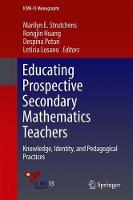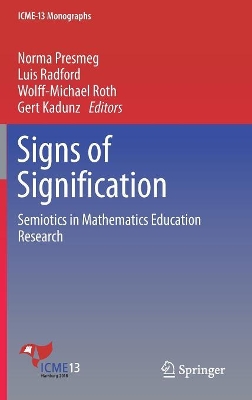Teaching and Learning Secondary School Mathematics
 -15%
portes grátis
-15%
portes grátis
Teaching and Learning Secondary School Mathematics
Canadian Perspectives in an International Context
Holm, Jennifer; Kajander, Ann; Chernoff, Egan J
Springer International Publishing AG
11/2018
695
Dura
Inglês
9783319923895
15 a 20 dias
1232
Descrição não disponível.
Front matter.- Series Preface (Gabriele Kaiser and Bharath Sriraman).- Preface. A northern vision of mathematics education (Ann Kajander, Jennifer Holm and Egan J. Chernoff).- Foreword (Edward Doolittle).- Part I. The Changing Landscape of Teaching and Learning Mathematics.- Part I preface. On changing the landscape: Ecclesiastes vs. Heraclitus (Rina Zazkis and Nathalie Sinclair).- Part I preface (Walter Whiteley).- Powerful stories: The hitchhiker's guide to the secondary mathematics curriculum landscape (Peter Taylor, Divya Lala, Kariane Ouellet, and Stefanie Knebel ).- On teaching and learning mathematics from a cultural-historical perspective (Luis Radford, Isaias Miranda, and Gilbert Lacroix).- Indigenous perspectives in school mathematics: From intellect to wisdom (Glen Aikenhead).- Live(d) topographies: The emergent and dynamical nature of ideas in secondary mathematics classes (Jennifer S. Thom and Florence Glanfield).- Drawing upon Indigenous knowledges to transform the secondary mathematics classroom (Lisa Lunney Borden).- A teacher's view It's a path, not a gap: A relationship-based approach to math and well-being (Tom Boland and David Tranter).- Part I commentary. The changing landscape of teaching and learning mathematics (Luckson M. Kaino (South Africa).- Part II. Shifting to a culture of inclusion .- Part II preface. The particular, the generic and the general once more:.- Looking into aspects of Canadian mathematics classrooms (David Pimm).- Steps toward a more inclusive mathematics pedagogy (Brent Davis, Jo Towers, Rohan Karpe, Michelle Drefs, Olive Chapman,and Sharon Friesen).- Learning mathematics when students are new to schooling and new to English (Richard Barwell, Kathryn Kubota-Zarivnij, and Debbie Culotta).- Introduction to students at risk: Case studies of often unheard students (Ann Kajander).- Building capacity in grade 9 mathematics: Case studies from a Collaborative Inquiry Project in Applied level mathematics (Douglas McDougall andSue Ferguson).- Success in Grade 9 Applied mathematics courses (Alison Macaulay).- Reflecting on good mathematics teaching: Knowing, nurturing, noticing (Susan Oesterle).- Mathematical mindsets for the teaching and learning of mathematics (Jamie S. Pyper).- Considering Indigenous perspectives and mathematics education: Stories of our experiences as teachers and teacher educators (Gladys Sterenberg and Kevin O'Connor).- A teacher's view.- An unexpected adventure (Jarron Childs and Jennifer Holm).- Part II commentary.- Shifting to a culture of inclusion (Kim Beswick (Australia)).- Part III: Fostering Relationships .- Part III preface. Building relationships through an ethic of care: Insights from the work of Julie Long (Elaine Simmt).- Culturing affect, affective cultures (Wolff-Michael Roth).- Support to thrive: Raising resilience in students in secondary schools (Kingsley Hurlington).- Digital technology in teaching mathematical competency: A paradigm shift (Sean Chorney).- Considering both academic and social domains: Increasing student engagement in at-risk classrooms (Limin Jao).- A teacher's view.- My favourite mistakes: Experiences teaching Cree students in northern communities (Michael Newell).- Part III commentary.- Fostering relationships in the work of teaching mathematics (Reidar Mosvold (Norway)).- Part IV: Enhancing Problem-based learning .- Part IV preface .- Enhancing problem-based learning (Tom Kieren).- Building thinking classrooms (Peter Liljedahl).- Teaching mathematics and developing citizenship: How to use contexts to enhance problem-based learning (Annie Savard).- Teaching probability in junior high school through problem solving: Construction and analysis of a probabilistic problem (Vincent Martin, Izabella Oliveira, and Laurent Theis ).- Bottles and bridges: Sample classroom tasks created by beginning teachers (Abrahim Abu Atiya, Natasha Luca, and Ann Kajander).- Promoting students' reasoning about statistical inference through engagement with a problem-based instructional activity involving the use of TinkerPlots (c) software (Luis Saldanha and Mathieu Thibault).- Supporting mathematical creativity through problem solving (Richard Hoshino).- Exploring math through social justice context problems (Ami Mamolo, Kevin Thomas, and Michael Frankfort).- Social justice and the teaching and learning of mathematics (Gale Russell ).- A teacher's view.- Problem solving in the secondary classroom (Shawn Godin).- Part IV commentary.- Developing mathematical reasoning through problem solving (Roza Leiken (Israel)).- Part IV commentary.- Doing is not the same as thinking or construing (John Mason (United Kingdom)).- Part V: Planning and Assessment .- Part V preface.- Planning and assessment: Teachers and students as central actors (Carolyn Kieran).- Planning a unit by starting with the end it mind: Unit and lesson planning (Jennifer Holm).- Observing for mathematical proficiency in secondary mathematics education(Priscila Dias Correa).- Re-framing testing to better fit within problem solving classrooms: Ways to create and review tests (Tina Rapke, Jennifer Hall, and Richelle Marynowski).- Enhancing mathematics teaching and learning through sound assessment practices (Christine Suurtamm).- Improving students' approaches to learning high school mathematics (P. Janelle McFeetors ).- A teacher's view.- Assessment: Broadening our conceptions to improve our practice (Jimmy Pai).- Part V commentary.- Planning and assessment from a South African perspective (Vijay Reddy (South Africa)).- Part V commentary .- On measures of measurement and mismeasurement: A commentary on planning and assessment (Bharath Sriraman (The United States of America)).- Part VI: Broadening mathematical understanding through content.- Part VI preface.- Broadening mathematical understanding through content (Gila Hanna).- "Canada is better" - An unexpected reaction to the order of operations in arithmetic (Rina Zazkis).- Modelling in mathematics education: Moving beyond curve fitting exercises (France Caron).- Learning algebra with models and reasoning (Ann Kajander).- In no uncertain terms: Encouraging a critical stance toward probability in school (Nat Banting, Ilona Vashchyshyn, and Egan J. Chernoff).- Composition of linear polynomials (Edward J. Barbeau).- Transition from secondary to tertiary mathematics.- Culture shock: Mathematical symbols, language, and reasoning (Andrijana Burazin and Miroslav Lovric).- A teacher's view.- Teaching a university bound statistics course (Jeff Gardner).- Part VI commentary.- Broadening mathematical understanding through content (Plinio Cavalcanti Moreira (Brazil)).- END MATTER.- Final commentary: The challenge continues (Jennifer Holm, Ann Kajander, and Egan J. Chernoff).- INDiCES.-
Este título pertence ao(s) assunto(s) indicados(s). Para ver outros títulos clique no assunto desejado.
Canada;educational technology;social justice;Indigenous education;classroom teachers;teacher professional development;STEM education;problem solving;Aboriginal education;students at-risk;assessment;student engagement;mathematical creativity;mathematical content knowledge;mathematical thinking;learning and instruction
Front matter.- Series Preface (Gabriele Kaiser and Bharath Sriraman).- Preface. A northern vision of mathematics education (Ann Kajander, Jennifer Holm and Egan J. Chernoff).- Foreword (Edward Doolittle).- Part I. The Changing Landscape of Teaching and Learning Mathematics.- Part I preface. On changing the landscape: Ecclesiastes vs. Heraclitus (Rina Zazkis and Nathalie Sinclair).- Part I preface (Walter Whiteley).- Powerful stories: The hitchhiker's guide to the secondary mathematics curriculum landscape (Peter Taylor, Divya Lala, Kariane Ouellet, and Stefanie Knebel ).- On teaching and learning mathematics from a cultural-historical perspective (Luis Radford, Isaias Miranda, and Gilbert Lacroix).- Indigenous perspectives in school mathematics: From intellect to wisdom (Glen Aikenhead).- Live(d) topographies: The emergent and dynamical nature of ideas in secondary mathematics classes (Jennifer S. Thom and Florence Glanfield).- Drawing upon Indigenous knowledges to transform the secondary mathematics classroom (Lisa Lunney Borden).- A teacher's view It's a path, not a gap: A relationship-based approach to math and well-being (Tom Boland and David Tranter).- Part I commentary. The changing landscape of teaching and learning mathematics (Luckson M. Kaino (South Africa).- Part II. Shifting to a culture of inclusion .- Part II preface. The particular, the generic and the general once more:.- Looking into aspects of Canadian mathematics classrooms (David Pimm).- Steps toward a more inclusive mathematics pedagogy (Brent Davis, Jo Towers, Rohan Karpe, Michelle Drefs, Olive Chapman,and Sharon Friesen).- Learning mathematics when students are new to schooling and new to English (Richard Barwell, Kathryn Kubota-Zarivnij, and Debbie Culotta).- Introduction to students at risk: Case studies of often unheard students (Ann Kajander).- Building capacity in grade 9 mathematics: Case studies from a Collaborative Inquiry Project in Applied level mathematics (Douglas McDougall andSue Ferguson).- Success in Grade 9 Applied mathematics courses (Alison Macaulay).- Reflecting on good mathematics teaching: Knowing, nurturing, noticing (Susan Oesterle).- Mathematical mindsets for the teaching and learning of mathematics (Jamie S. Pyper).- Considering Indigenous perspectives and mathematics education: Stories of our experiences as teachers and teacher educators (Gladys Sterenberg and Kevin O'Connor).- A teacher's view.- An unexpected adventure (Jarron Childs and Jennifer Holm).- Part II commentary.- Shifting to a culture of inclusion (Kim Beswick (Australia)).- Part III: Fostering Relationships .- Part III preface. Building relationships through an ethic of care: Insights from the work of Julie Long (Elaine Simmt).- Culturing affect, affective cultures (Wolff-Michael Roth).- Support to thrive: Raising resilience in students in secondary schools (Kingsley Hurlington).- Digital technology in teaching mathematical competency: A paradigm shift (Sean Chorney).- Considering both academic and social domains: Increasing student engagement in at-risk classrooms (Limin Jao).- A teacher's view.- My favourite mistakes: Experiences teaching Cree students in northern communities (Michael Newell).- Part III commentary.- Fostering relationships in the work of teaching mathematics (Reidar Mosvold (Norway)).- Part IV: Enhancing Problem-based learning .- Part IV preface .- Enhancing problem-based learning (Tom Kieren).- Building thinking classrooms (Peter Liljedahl).- Teaching mathematics and developing citizenship: How to use contexts to enhance problem-based learning (Annie Savard).- Teaching probability in junior high school through problem solving: Construction and analysis of a probabilistic problem (Vincent Martin, Izabella Oliveira, and Laurent Theis ).- Bottles and bridges: Sample classroom tasks created by beginning teachers (Abrahim Abu Atiya, Natasha Luca, and Ann Kajander).- Promoting students' reasoning about statistical inference through engagement with a problem-based instructional activity involving the use of TinkerPlots (c) software (Luis Saldanha and Mathieu Thibault).- Supporting mathematical creativity through problem solving (Richard Hoshino).- Exploring math through social justice context problems (Ami Mamolo, Kevin Thomas, and Michael Frankfort).- Social justice and the teaching and learning of mathematics (Gale Russell ).- A teacher's view.- Problem solving in the secondary classroom (Shawn Godin).- Part IV commentary.- Developing mathematical reasoning through problem solving (Roza Leiken (Israel)).- Part IV commentary.- Doing is not the same as thinking or construing (John Mason (United Kingdom)).- Part V: Planning and Assessment .- Part V preface.- Planning and assessment: Teachers and students as central actors (Carolyn Kieran).- Planning a unit by starting with the end it mind: Unit and lesson planning (Jennifer Holm).- Observing for mathematical proficiency in secondary mathematics education(Priscila Dias Correa).- Re-framing testing to better fit within problem solving classrooms: Ways to create and review tests (Tina Rapke, Jennifer Hall, and Richelle Marynowski).- Enhancing mathematics teaching and learning through sound assessment practices (Christine Suurtamm).- Improving students' approaches to learning high school mathematics (P. Janelle McFeetors ).- A teacher's view.- Assessment: Broadening our conceptions to improve our practice (Jimmy Pai).- Part V commentary.- Planning and assessment from a South African perspective (Vijay Reddy (South Africa)).- Part V commentary .- On measures of measurement and mismeasurement: A commentary on planning and assessment (Bharath Sriraman (The United States of America)).- Part VI: Broadening mathematical understanding through content.- Part VI preface.- Broadening mathematical understanding through content (Gila Hanna).- "Canada is better" - An unexpected reaction to the order of operations in arithmetic (Rina Zazkis).- Modelling in mathematics education: Moving beyond curve fitting exercises (France Caron).- Learning algebra with models and reasoning (Ann Kajander).- In no uncertain terms: Encouraging a critical stance toward probability in school (Nat Banting, Ilona Vashchyshyn, and Egan J. Chernoff).- Composition of linear polynomials (Edward J. Barbeau).- Transition from secondary to tertiary mathematics.- Culture shock: Mathematical symbols, language, and reasoning (Andrijana Burazin and Miroslav Lovric).- A teacher's view.- Teaching a university bound statistics course (Jeff Gardner).- Part VI commentary.- Broadening mathematical understanding through content (Plinio Cavalcanti Moreira (Brazil)).- END MATTER.- Final commentary: The challenge continues (Jennifer Holm, Ann Kajander, and Egan J. Chernoff).- INDiCES.-
Este título pertence ao(s) assunto(s) indicados(s). Para ver outros títulos clique no assunto desejado.
Canada;educational technology;social justice;Indigenous education;classroom teachers;teacher professional development;STEM education;problem solving;Aboriginal education;students at-risk;assessment;student engagement;mathematical creativity;mathematical content knowledge;mathematical thinking;learning and instruction






